Humidity, the presence of moisture in the air, is a defining factor in the climate of a region, shaping everything from daily life to ecosystems. The sensation of humid air on the skin, the misty landscapes, and the lush vegetation are all influenced by atmospheric moisture levels. However, some countries experience more humidity than others. Read below to find out the top 12 countries with high levels of humidity.
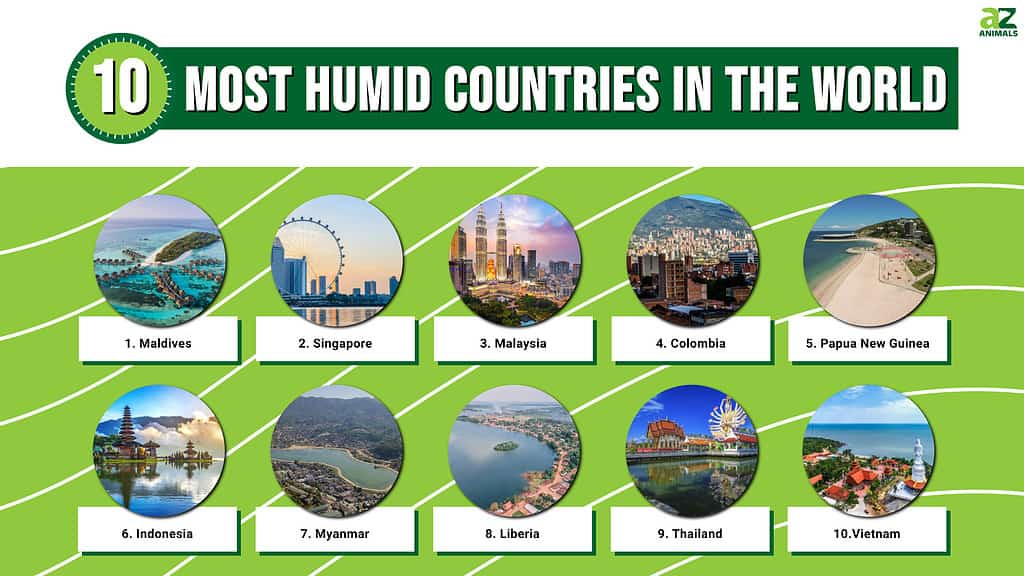
1. Maldives
Known for its breathtaking coral atolls, turquoise waters, and luxurious resorts, the Maldives is a tropical paradise of natural beauty. Its equatorial location in the heart of the Indian Ocean also makes it the most humid country in the world. Warm ocean currents sweep over the archipelago of over 1,000 islands, infusing the atmosphere with moisture year-round. Thus, humidity is an integral part of daily life.
Despite the challenges posed by such high humidity levels, the Maldivian people have cultivated an enduring relationship with their environment. Traditional architecture showcases ingenuity in the face of humid conditions. Islanders build homes on stilts to mitigate the effects of rising sea levels and to allow better airflow. They have also harnessed their natural surroundings to construct thatched roofs and woven walls, which provide both shelter and ventilation.
Beyond architecture, the Maldivian culture and cuisine also flourish under the humid embrace of the Indian Ocean air. Fresh seafood abounds in local dishes, and coconut water serves as a natural coolant, offering refreshment against the ever-present humidity. The Maldives’ humid climate is not just a climatic characteristic. it’s a fundamental aspect of the nation’s identity. It shapes how its people live, build, and celebrate amidst the unparalleled beauty of their tropical haven.

The Maldives is the most humid country in the world.
©Siraphob Werakijpanich/Shutterstock.com
2. Singapore
Singapore is a small but vibrant island nation in Southeast Asia. It also holds the distinction of being the second most humid country in the world. Nestled near the equator, Singapore experiences a tropical rainforest climate that ensures high levels of humidity throughout the year. The warm temperatures and abundant rainfall contribute to the perpetual presence of moisture in the air. Thus, this creates an atmosphere that residents and visitors can practically feel on their skin. The city-state’s stunning skyline, lush greenery, and modern urban design are all shaped by its humid climate.
Despite its humid conditions, Singapore has adeptly integrated its climate into its way of life. The city’s architecture reflects its commitment to providing indoor sanctuaries from the humidity. Air-conditioned malls, museums, and attractions offer respite from outdoor air. Additionally, Singaporeans have developed a culture of adapting to the weather. They favor light and breathable clothing that allow them to navigate the city’s streets comfortably.
The country is also renowned for its green spaces, such as the Gardens by the Bay and Sentosa’s nature reserves. These tropical rainforest landscapes showcase Singapore’s determination to harmonize with its humid environment. Singapore also has an innovative approach to urban planning, incorporating vertical gardens and sky bridges. This demonstrates how a nation can weave its climate into its urban fabric.
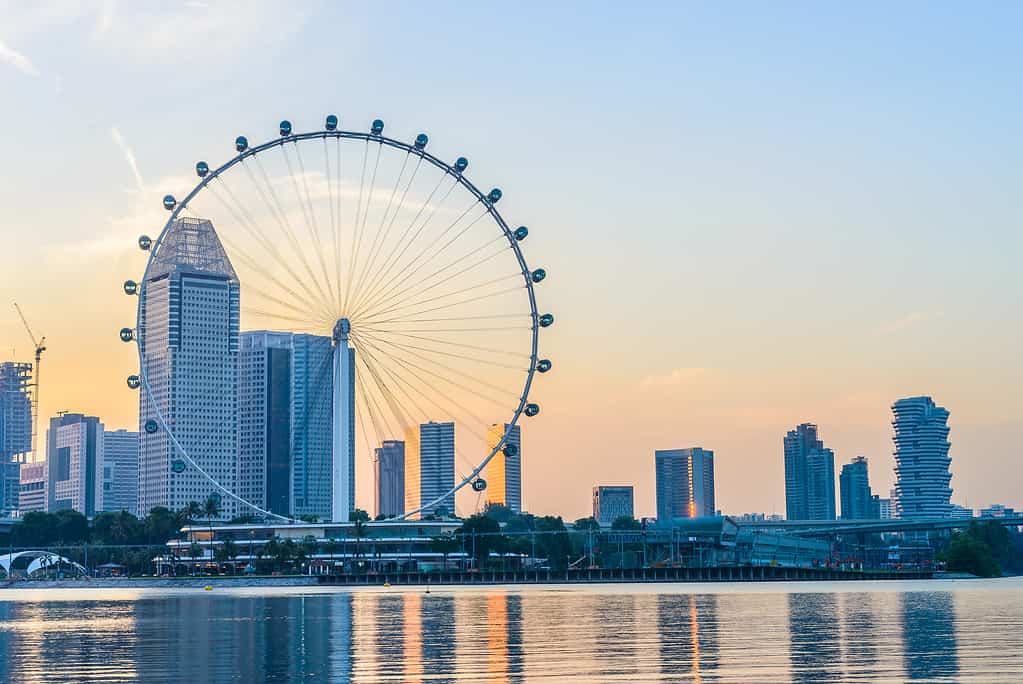
Singapore has extremely high humidity all year round, but it manages to find a way to keep cool.
©Lifestyle Travel Photo/Shutterstock.com
3. Malaysia
Nestled within the equatorial belt of Southeast Asia, Malaysia is renowned for its vibrant culture. It has stunning landscapes as well as a climate that envelops visitors in a warm and humid embrace. Its equatorial location and abundant rainfall contribute to its being one of the most humid countries in the world. From the bustling streets of Kuala Lumpur to the tranquil shores of Langkawi, humidity is an ever-present companion in Malaysia. It shapes the rhythm of daily life as well as the lushness of the natural environment.
Malaysia‘s humid climate, with relative humidity often exceeding 80%, plays a pivotal role in shaping its diverse ecosystems. The dense rainforests, home to diverse plant and animal species, thrive on the consistent moisture in the air. This humidity fosters the growth of unique flora such as orchids and ferns. It also provides a haven for exotic creatures like the proboscis monkey and the elusive clouded leopard. Therefore, the country’s ecosystems are intrinsically intertwined with the humid atmosphere. Moreover, the lush greenery and vibrant wildlife captivate both residents and visitors alike.
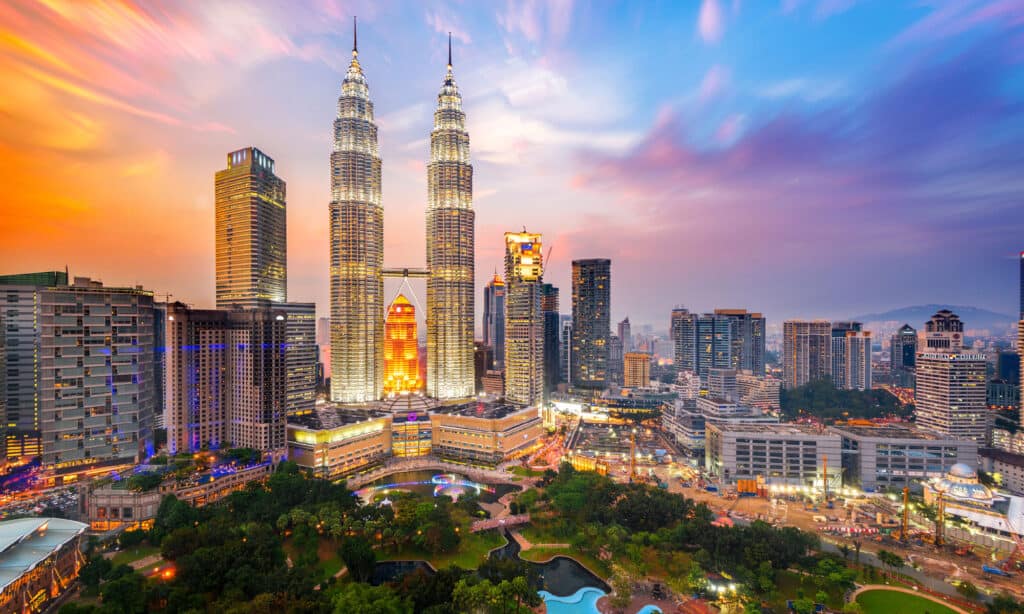
Malaysia’s beautiful hills and mountains are kept green all year round because of the humidity.
©iStock.com/Rat0007
4. Colombia
Colombia is a land of breathtaking landscapes and rich biodiversity. It also claims to be one of the most humid countries due to its diverse geography and equatorial location. Colombia‘s equatorial position ensures that it experiences consistently high humidity levels throughout the year. The warm, moist air from the Atlantic Ocean and the Caribbean Sea converges over the country. Therefore, this fosters an environment that sustains its lush rainforests, fertile valleys, and vibrant ecosystems.
From the Amazon rainforest to the Andean highlands, humidity supports the country’s diverse flora and fauna. There is abundant rainfall in regions like Chocó, known as one of the rainiest places on Earth. This contributes to the proliferation of stunning plant life and complex ecosystems. However, the humid climate can also pose challenges for infrastructure maintenance and preservation of historical sites. Sometimes, it also offers opportunities for sustainable practices and innovative architectural designs that cater to the moisture-rich environment. Therefore, the fusion of Colombia’s indigenous heritage, cultural celebrations and biodiversity with its humid climate creates an extraordinary blend of traditions and ecosystems.

Colombia is one of the rainiest countries in the world and also experiences high humidity.
©Edder282/Shutterstock.com
5. Papua New Guinea
Nestled in the southwestern Pacific Ocean, Papua New Guinea is one of the most humid countries in the world. Its equatorial location ensures a climate characterized by high humidity levels, often exceeding 80%. The lush rainforests, vibrant coastal regions, and mountainous landscapes are all shaped by moisture. Therefore, the people of Papua New Guinea have adapted to this environment through a close connection with the land.
The humid climate of Papua New Guinea plays a pivotal role in sustaining its rich biodiversity. The dense rainforests thrive on moisture, creating habitats for an astounding array of plant and animal species found nowhere else on Earth. The country’s indigenous communities have also developed deep relationships with these ecosystems. They rely on the bounty of the land for sustenance as well as cultural expression. Despite the challenges posed by humidity, the people of Papua New Guinea have embraced their environment. Furthermore, they have created a unique way of life that emphasizes community bonds, resourcefulness, and a profound respect for the natural world.

Papua New Guinea has a lot of humidity in the air all year round.
©Eugene Emau Wemin/Shutterstock.com
6. Indonesia
Nestled within the expansive archipelago of Southeast Asia, Indonesia is one of the most humid countries in the world, where the air hangs heavy with moisture year-round. Its equatorial position near the Earth’s equator ensures that the sun’s rays strike the region almost directly. This warms the vast expanse of ocean waters that envelop the nation’s thousands of islands. As these waters heat up, they release copious amounts of moisture into the atmosphere, creating an environment where humidity thrives. Therefore, the result is a climate where humidity becomes an intrinsic part of daily life. It shapes everything from the landscapes to cultural practices.
Indonesia‘s humidity creates a lush canvas of tropical rainforests, vibrant rice terraces, and verdant landscapes. These ecosystems are nourished by the abundant rainfall that humidity facilitates, thus sustaining the diverse flora and fauna that thrive amidst the moisture. From the iconic orangutans of Borneo to the vibrant coral reefs surrounding its islands, Indonesia’s biodiversity is deeply intertwined with its humid climate. Yet, this humidity also presents challenges from preserving historical architecture in bustling cities like Jakarta to fostering comfortable living conditions in its rural communities.

Indonesia’s beautiful landscapes are nurtured by the humid climate.
©Guitar photographer/Shutterstock.com
7. Myanmar
Myanmar, nestled in the heart of Southeast Asia, stands as one of the most humid countries in the world. Its atmosphere is steeped in moisture and rich in cultural heritage. The nation’s equatorial location, coupled with its diverse landscapes, contributes to its high humidity levels, especially during the monsoon season. As warm, moist air wafts across the lush landscapes of Myanmar, it weaves its way through ancient temples, bustling markets, and vibrant communities. The humidity envelops the vibrant city of Yangon, where colonial architecture and bustling streets coexist with the moisture-laden air. Therefore, it gives rise to a unique ambiance that resonates with the nation’s history and culture.
Amidst this humid embrace, Myanmar’s cultural heritage thrives. The mist-shrouded temples of Bagan, with their ancient stupas rising majestically from the earth, create an ethereal scene that is deeply intertwined with the humid environment. It also intertwines with the aromas of street food stalls which offer delicacies that have been perfected over generations.
From the tranquil waters of Inle Lake to the bustling alleyways of Mandalay, Myanmar’s humid climate also influences the rhythm of daily life. It also shapes the textiles woven by skilled artisans and the vibrant festivals that celebrate the nation’s diverse traditions.
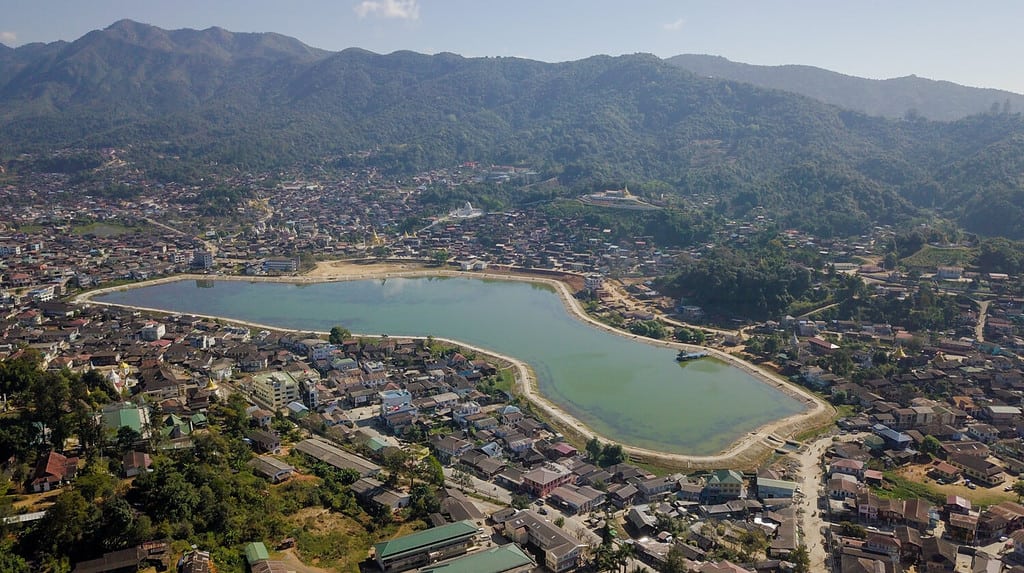
Myanmar is one of the most humid countries in the world.
©Ge-No/Shutterstock.com
8. Liberia
Liberia, situated along the West African coast, is one of the most humid countries in the world. Its equatorial location and proximity to the Atlantic Ocean contribute to its consistently high humidity levels. The nation’s tropical rainforests, teeming with lush vegetation and diverse ecosystems, thrive in this humid climate. The air is laden with moisture, creating an environment where dense canopies of trees, vibrant flowers, and unique wildlife flourish.
This natural abundance, however, comes with challenges, as the humidity can foster conditions that are conducive to mold, rust, and corrosion. Liberians have adapted to their humid surroundings by incorporating ventilation into architectural designs. They also favor lightweight clothing and seek refuge in shaded outdoor spaces. Despite the challenges, Liberia’s resilience shines through in its vibrant culture, rich traditions, and lively celebrations. These are a testament to the human spirit’s ability to thrive in even the most humid of environments.
The humid air in Liberia serves as a backdrop to cultural vibrancy and a deep connection to the land. The nation’s music, dance, and art reflect the intertwining of tradition and the humid environment. Marketplaces bustle with activity as locals trade goods and engage in community interactions. They also have open-air gathering spaces that provide respite from the humidity while fostering a sense of togetherness. Liberia’s humid climate has shaped its way of life, influencing clothing choices, architectural innovations, and the cultivation of crops suited to the region’s moisture-rich conditions. The nation’s resilience in the face of its humid environment is not just evident in its architecture and daily life. It is also evident in its ability to celebrate and share its cultural heritage with the world.
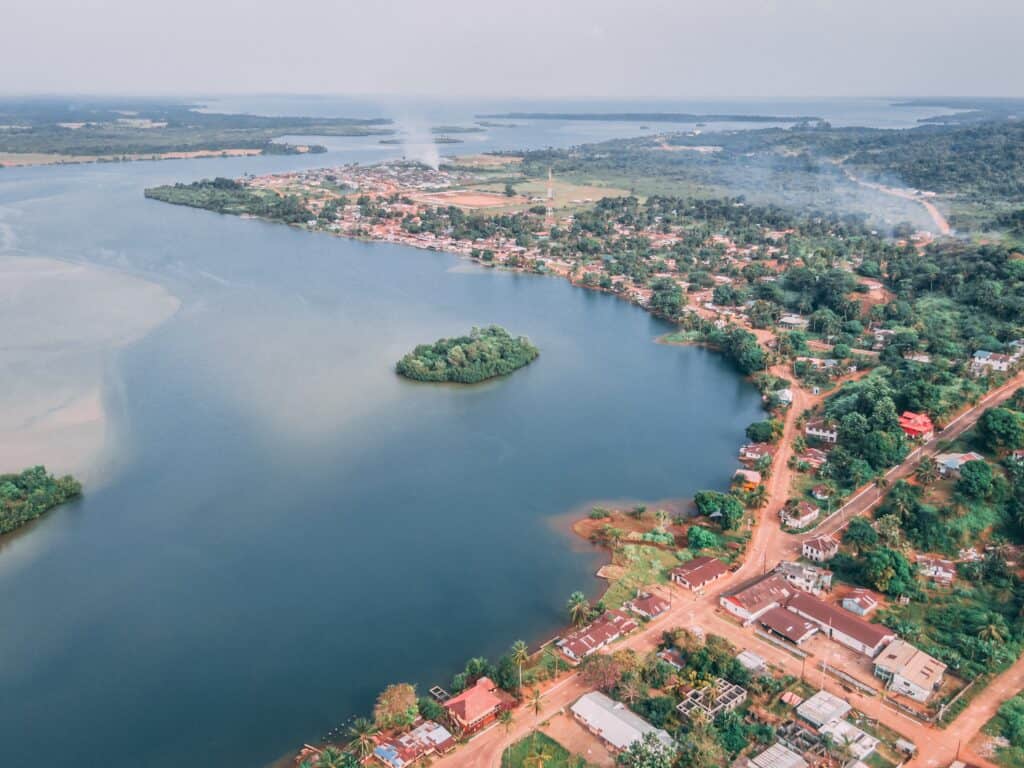
Liberia’s culture is largely inspired by its tropical location and humidity levels.
©Wirestock Creators/Shutterstock.com
9. Thailand
Nestled in the heart of Southeast Asia, Thailand is one of the most humid countries in the world, where the air itself seems to carry a palpable embrace of moisture. Its tropical climate, characterized by high temperatures and abundant rainfall, creates an environment where humidity thrives year-round. The nation’s geographical diversity, from bustling cities to serene landscapes, is also equally united by the presence of humid air.
Thailand’s humid climate plays a defining role in shaping its cultural landscape and daily life. In the vibrant street markets of Bangkok, the aromas of local delicacies fill the air. It is also present amidst the ornate temples that adorn the countryside. The country’s iconic rice fields, stretching across the countryside in terraced splendor, are not only a testament to Thailand’s agricultural prowess but also a reflection of the synergy between its climate and its people’s resourcefulness.
The nation’s ability to coexist harmoniously with humidity is further exemplified in its architectural designs. Those are characterized by open spaces and natural ventilation to provide respite from the moisture-laden air. While the humidity may evoke moments where one wants to only savor a refreshing coconut, it also enhances the lushness of Thailand’s landscapes. They turn every vista into a scene of greenery that is as vivid as its culture.
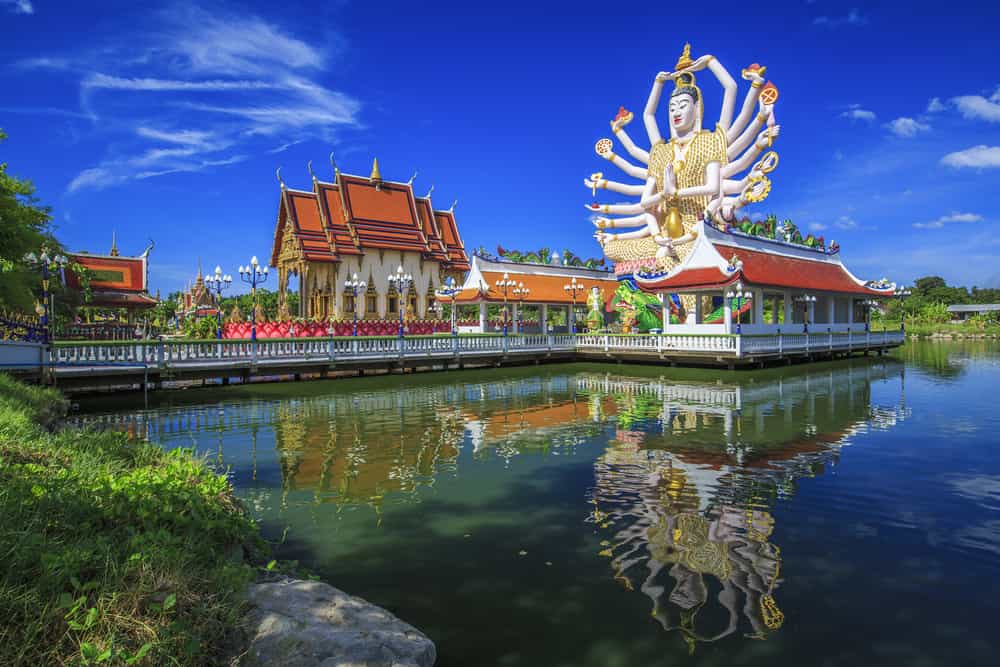
Wat Plai Laem temple in Thailand is an important place showing open-air spaces built to counter humidity.
©nate samui/Shutterstock.com
10. Vietnam
Vietnam is one of the most humid countries in the world, defined by its tropical monsoon climate that ushers in abundant moisture and high humidity levels. With its diverse landscapes ranging from verdant rice fields to bustling urban centers, Vietnam‘s humid environment significantly influences every facet of daily life. The nation experiences distinct wet and dry seasons. The humid air becomes really palpable during the monsoon months. The southwest monsoon sweeps across the country from April to September and brings heavy rainfall, creating a landscape that thrives on the nourishing moisture. The humidity contributes to the country’s lush and vibrant ecosystems, making Vietnam a haven for biodiversity. The tropical rainforests and iconic rice paddies that paint the countryside stay a vivid green all year round.
Vietnam’s ability to adapt to its humid climate is evident in its architecture, food culture, and bustling street life. Traditional homes often have open-air designs that allow for natural ventilation, enabling residents to cope with the humid air. The cuisine, which is rich in fresh herbs and bold flavors, also mirrors the country’s humid landscapes. The culinary offerings at bustling markets which offer tropical fruits are also intertwined with the moist air that defines the environment.
Moreover, Vietnamese society embraces its humid identity through cultural celebrations, like the Lunar New Year, where traditions and rituals flourish amidst the moisture-laden air. In essence, Vietnam’s humid climate shapes its identity, fostering an intricate connection between nature and culture.
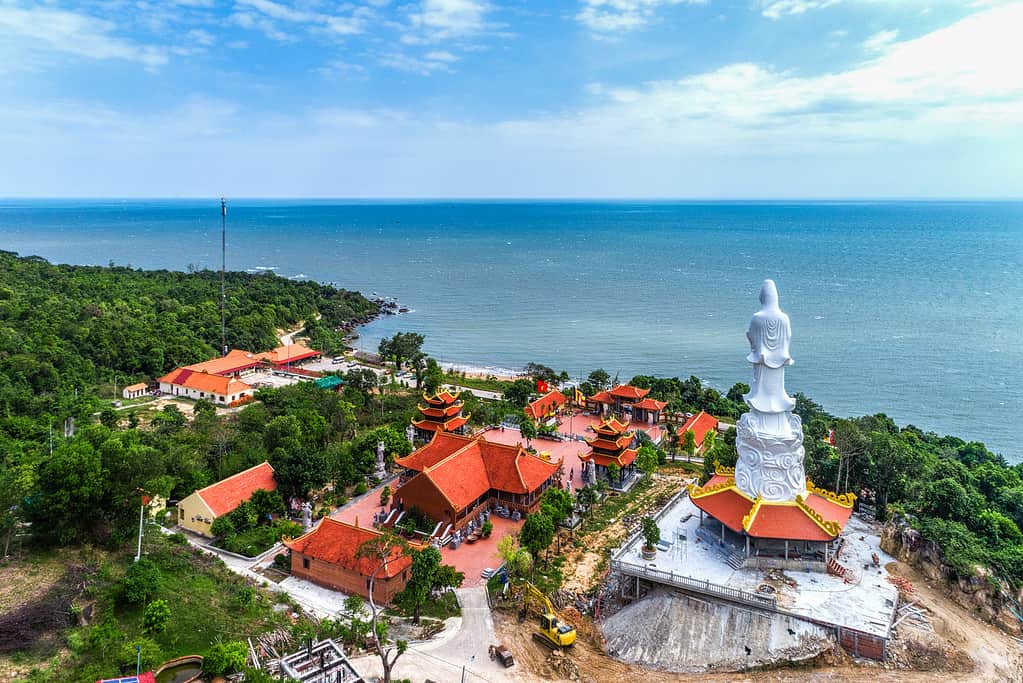
Phu Quoc is full of memorable sites including Ho Quac Pagoda, which looks vibrant because of the year-round humidity.
©Nguyen Quang Ngoc Tonkin/Shutterstock.com
11. Nigeria
Nigeria, situated in West Africa, is one of the most humid countries in the world. This characteristic is shaped by its equatorial location and its proximity to the Atlantic Ocean. The nation’s tropical climate ensures that humidity is a constant presence, particularly in the southern regions. The humid air envelopes Nigeria’s lush rainforests, fertile plains, and bustling cities alike. The country’s weather patterns are influenced by the West African monsoon, which brings heavy rains during the wet season and contributes to the humidity that prevails throughout the year.
Amidst this humidity, Nigeria’s cultural vibrancy and daily life thrive. The warmth of the humid air is matched by the warmth of its people, who have adapted to this environment over generations. Traditional festivals, musical celebrations, and colorful markets all thrive in the Nigerian landscape, carried out with a sense of camaraderie that resonates even in the most humid of conditions.
Nigeria’s architectural designs often prioritize ventilation, allowing for comfortable living in the face of high humidity. From lightweight clothing choices to the creation of open-air communal spaces, Nigerians have cultivated ways to stay connected to their heritage while embracing the natural elements that define their climate.
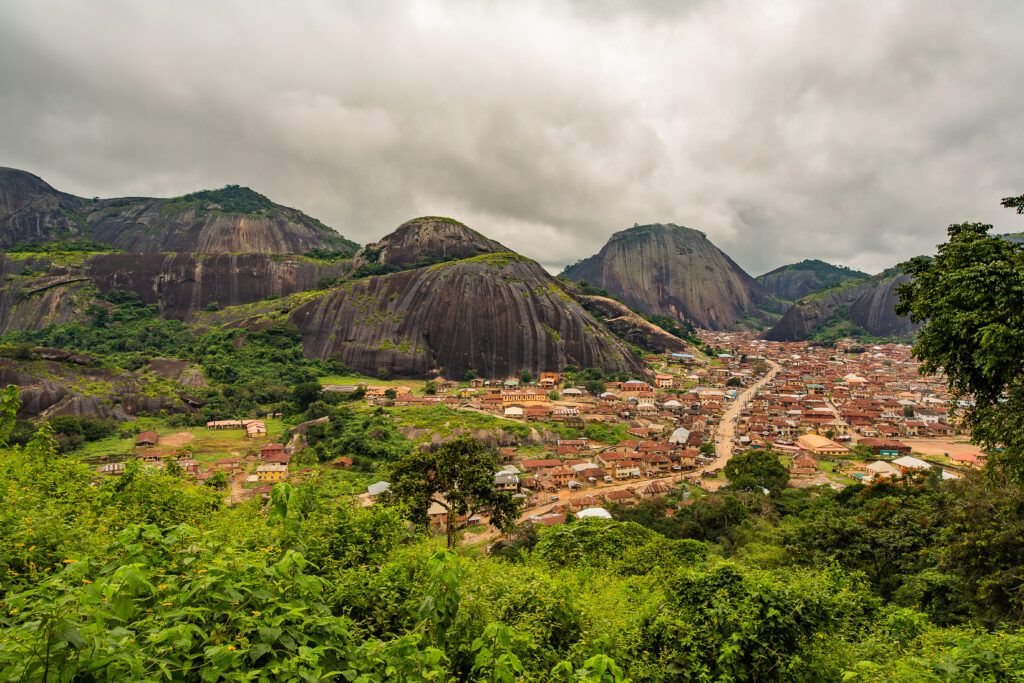
Idanre Hill is one of the most beautiful natural landscapes in Nigeria and stays green year round because of the humidity.
©Fela Sanu/Shutterstock.com
12. India
India, with its diverse landscapes, cultural richness, and historical significance, ranks among the most humid countries in the world. The country’s humid climate is intricately linked to its geographical and meteorological characteristics. The monsoon, a defining meteorological phenomenon in India, plays a pivotal role in shaping its humidity levels. The seasonal shift from dry to wet during the monsoon brings relief from scorching temperatures but also introduces high humidity levels. The warm, moisture-laden winds that sweep across the Indian Ocean and the Arabian Sea infuse the air with humidity, resulting in the characteristic dampness that defines much of India’s climate.
The presence of humidity in India has profound cultural and environmental implications. Traditional architectural designs, including high ceilings, courtyards, and cross-ventilation, show an adaptation to the humid climate. These designs facilitate natural airflow and mitigate the discomfort caused by excessive moisture in the air. The humidity also influences India’s renowned cuisine, as spices and flavors take on a unique depth in the moist air. Additionally, the monsoons also nourish the country’s agricultural lands and support the cultivation of staple crops.
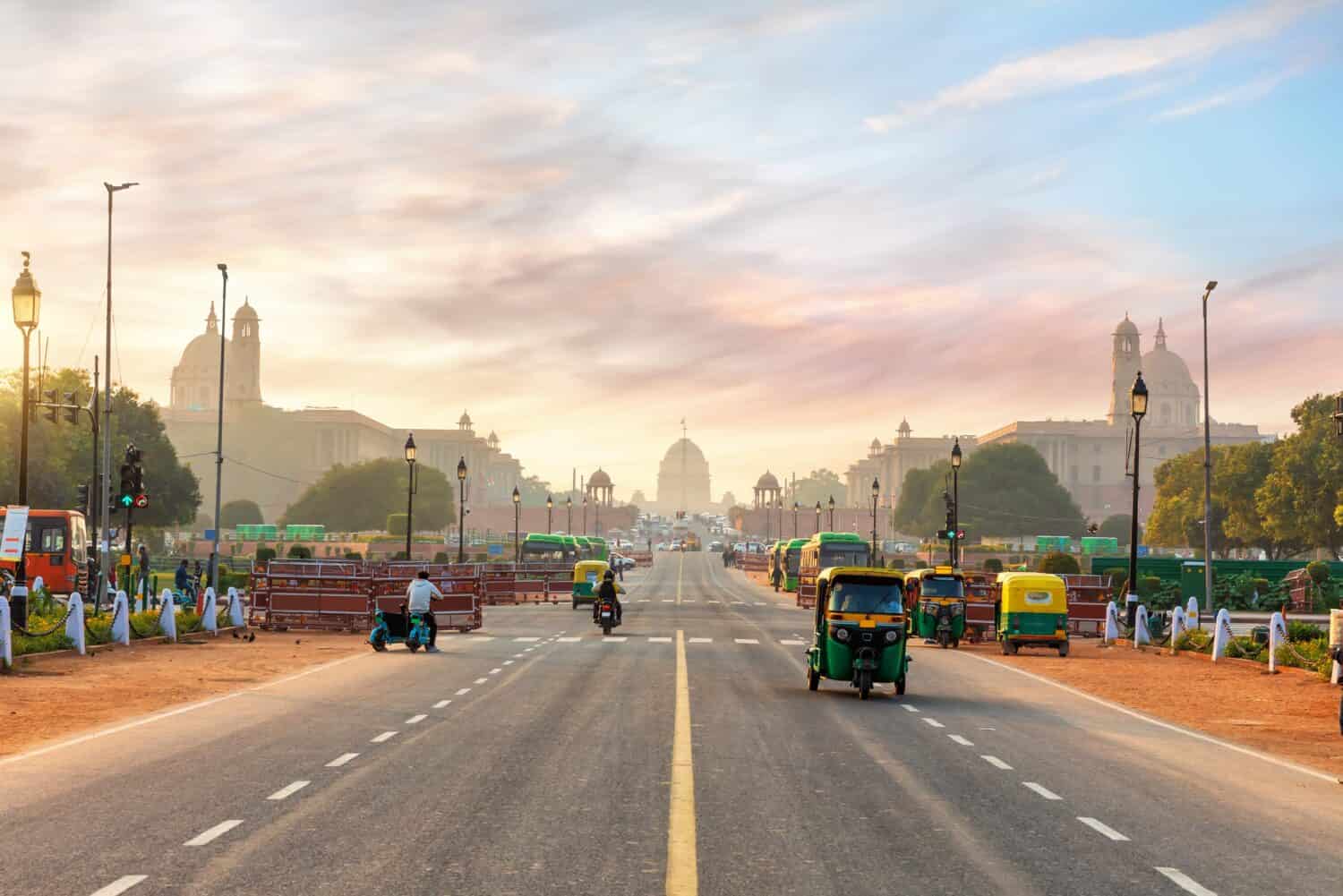
New Delhi is one of the most humid places in India, especially during the summer.
©AlexAnton/Shutterstock.com
Summary of the Top 12 Most Humid Countries in the World
| Rank | Country | Humidity Characteristics |
|---|---|---|
| 1 | Maldives | High humidity due to equatorial location and warm ocean waters. |
| 2 | Singapore | Tropical rainforest climate results in consistently high humidity. |
| 3 | Malaysia | Equatorial climate brings abundant rainfall and warm temperatures. |
| 4 | Colombia | Tropical and equatorial locations lead to lush landscapes and high humidity. |
| 5 | Papua New Guinea | Equatorial location contributes to a humid atmosphere year-round. |
| 6 | Indonesia | Varied landscapes and equatorial climate result in pervasive humidity. |
| 7 | Myanmar | Humidity is prevalent, particularly during the monsoon season. |
| 8 | Liberia | Equatorial position and proximity to the ocean contribute to high humidity. |
| 9 | Thailand | Tropical climate creates consistently humid conditions. |
| 10 | Vietnam | Humid atmosphere is a result of tropical monsoon patterns. |
| 11 | Nigeria | Equatorial climate and cultural richness coexist with humidity. |
| 12 | India | Monsoons and diverse landscapes lead to varying levels of humidity. |
The photo featured at the top of this post is © Stephane Bidouze/Shutterstock.com
Thank you for reading! Have some feedback for us? Contact the AZ Animals editorial team.






